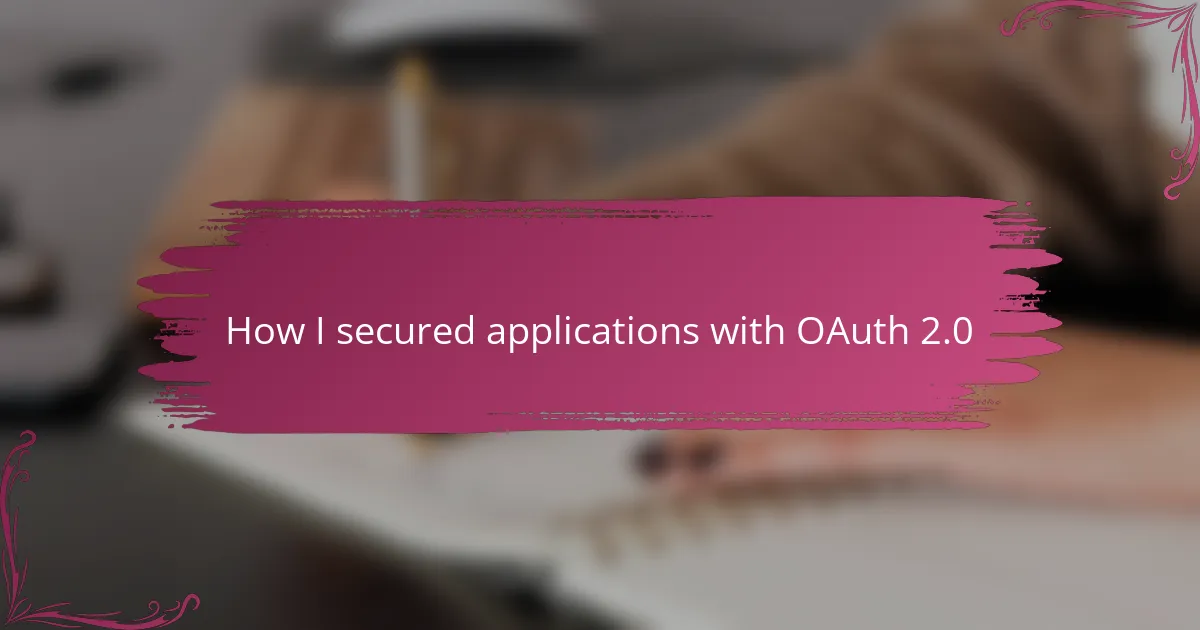Key takeaways
- OAuth 2.0 enhances security by using access tokens instead of passwords, allowing users to control data access.
- Configuring redirect URIs and scopes accurately is crucial for a successful authorization process.
- Token management should prioritize security, including encryption and short lifespan, to mitigate vulnerabilities.
- Building fallback mechanisms for user consent and handling errors improves overall user experience and application reliability.

Understanding OAuth 2.0 Basics
When I first encountered OAuth 2.0, I was struck by how elegantly it handles the tricky problem of authorization—granting limited access to user data without sharing sensitive credentials. Have you ever wondered how apps ask for permission to access your information without compromising your password? That’s the magic OAuth 2.0 delivers.
At its core, OAuth 2.0 acts like a trusted intermediary between users and applications. Instead of handing over passwords, it issues what’s called an access token—a digital key with specific permissions and a limited lifetime. This approach not only improves security but also gives users more control over what data they share.
What really convinced me of OAuth 2.0’s power was seeing how it supports different “flows” or methods tailored to various types of applications, from web apps to mobile clients. Each flow adapts the process to best fit the app’s environment, balancing ease of use with safety. Understanding these basics was the first step in confidently securing my own applications.

Setting Up OAuth for Applications
Getting started with OAuth 2.0 felt a bit overwhelming at first—I wasn’t sure where to begin. But once I registered my application with the authorization server, everything started to click. This registration gave me essential details like the client ID and client secret, which felt like the app’s official ID card in the OAuth ecosystem.
Next came configuring the redirect URIs, which I quickly learned is a crucial step. I remember underestimating their importance until I realized that any mistake here could block the whole authorization process. Redirect URIs ensure that after a user grants permission, they get sent back safely to the right place in the app.
Finally, setting the appropriate scopes was a moment where I understood OAuth’s real flexibility. Instead of asking for broad access, I tailored permissions to just what my app needed. It felt empowering to decide exactly what data my application could touch, and I’m confident that this step kept my users’ information much safer. Have you tried customizing scopes for your apps yet? It’s a game changer.

Implementing OAuth in Code
When I dove into coding OAuth, the first hurdle was handling the token exchange correctly. Making sure my app requested the right authorization code and then swapped it for an access token without exposing secrets felt like learning a new language. Have you ever spent hours debugging just because a single parameter was off? That’s the kind of precision OAuth demands.
Integrating OAuth libraries helped me a lot—using well-tested SDKs reduced the chance of mistakes and sped up development. Still, I made it a point to understand the underlying HTTP requests, because blindly trusting black-box code never sat well with me. Knowing how the authorization header should be formatted saved me countless headaches during API calls.
One key insight was managing token refresh logic. I didn’t realize until deployment how frustrating it was when access tokens expired unexpectedly and users were kicked out. Implementing seamless token refreshes behind the scenes not only improved security but also kept my users happy with uninterrupted service. Have you thought about how your app handles token lifecycles? It’s a subtle detail, but it makes a huge difference.

Handling Authorization Flow
Handling the authorization flow in OAuth 2.0 initially felt like navigating a maze for me. I learned that each step, from requesting the authorization code to exchanging it for an access token, needs to be flawless—one small misstep can break the entire process. Have you ever felt that mix of frustration and satisfaction when finally getting this flow right? That moment always feels like a win.
What helped me enormously was paying extra attention to the redirect URI during this flow. It acts like a checkpoint ensuring the user returns safely to the app after granting permissions. I recall the countless times I had to double-check this URL to prevent annoying errors where users got lost or blocked—trust me, precision here is non-negotiable.
Another thing I discovered is the importance of gracefully handling user consent and possible failures in the flow. Sometimes users deny permission or network hiccups occur, and your app has to respond smoothly without crashing or confusing the user. Thinking through these scenarios beforehand made my apps feel far more reliable and polished. Have you built in fallback plans for when things don’t go as planned? It’s worth the effort.

Managing Tokens Securely
Managing tokens securely became one of those moments where I realized that overlooking small details could lead to big vulnerabilities. Have you ever thought about what would happen if someone else got hold of your access tokens? That risk pushed me to treat tokens like precious keys—never storing them in places anyone could easily reach, like local storage or logs.
I found that encrypting tokens and limiting their lifespan was a game changer. By making tokens short-lived and requiring periodic refreshes, I could minimize damage if a token ever slipped out. Implementing secure storage mechanisms, like HTTP-only cookies or secure vaults, gave me peace of mind knowing my tokens weren’t just floating around vulnerable to interception.
One tricky part was balancing usability with security. For instance, I kept refresh tokens more protected and tightly controlled, since they grant new access tokens. I also added checks to detect unusual token usage patterns, which helped catch potential breaches early. Do you monitor your tokens actively? It may sound like extra work, but from my experience, it’s essential for keeping your app safe in the long run.

Common OAuth Security Practices
One practice I always stick to is using HTTPS everywhere in the OAuth flow. It might sound obvious, but I’ve seen how lax implementation leads to token interception and complete compromise. Have you ever paused to consider how even a tiny unsecured request could expose all your users’ data? That’s why encrypting traffic is non-negotiable in my projects.
Another habit I picked up was strictly validating redirect URIs every single time. Early on, I underestimated how attackers could exploit open redirect flaws to hijack tokens. After a few nerve-wracking debugging sessions, I now treat URI validation as a critical gatekeeper—any mismatch and the request gets rejected immediately. It’s a simple step that saved me from nightmares involving stolen access.
I also never skip implementing proper token scopes and least privilege principles. Asking for only what the application truly needs limits fallout if something goes wrong. When I started narrowing scopes thoughtfully, it felt like giving out keys for just the right rooms instead of handing over the whole house. Have you experimented with tightening your scope definitions? From my experience, it’s a small effort with huge payoffs for security.

Personal Insights on OAuth Integration
What truly stood out to me during OAuth integration was the unexpected complexity hidden beneath its seemingly straightforward process. Have you ever found yourself thinking, “This should be simple,” only to get tangled in subtle nuances like token scopes and redirect URI precision? I certainly did, and wrestling with those details made me appreciate just how delicate OAuth’s balance between security and usability really is.
One personal insight I gained is that OAuth integration isn’t just about following specs—it’s about anticipating real-world situations users might face. I remember building fallback handling for denied permissions and interrupted flows, which initially felt like overkill. But when users actually encountered these cases and the app handled them gracefully, it reinforced for me that robust OAuth implementation is as much about user experience as it is about security.
Lastly, I found that treating OAuth tokens like fragile treasures changed my whole approach. Instead of just securing them and moving on, I kept asking myself, “Could this token leak? How would I detect it?” This mindset shifted my coding habits and led me to implement more proactive monitoring and defense strategies than I ever expected. It’s that kind of continual vigilance, not just initial setup, that truly secures applications in the long run.